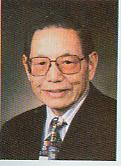
Huang Zhangren, male, born in November 1916 in Liuyang, Hunan. He graduated from the Department of Civil Engineering of Wuhan University in 1938, and later earned his Doctor`s Degree og Engineering in University of Michigan, USA in 1952, in 1990, and he was granted Honorary Ph.D by the Central Connecticut State University.
I: Working Experiences
1938—1950 Deputy Chief Engineer of The Republic of China Air Force Engineering Department;
1950—1951 Associate Professor of the Department of Civil Engineering of National Taiwan University;
1953—1954 Bridge Enginner of Federal Highway Administration of Michigan; Also the Construction Engineer of J.G.WHITE(NEW YORK);
1955—1981 Excecutive Manager of Sammy Industrial Co. ltd(THAILAND) and Chairman of Sammy Petros(THAILAND). Spending more than 20 years in Thailand running petroleum business, he has built an oil refinery with a daily capacity of 65000 barrels of crude oil and gas stations of more than 150 sites. During the energy crisis, it was him who increased the capacity when others had to reduce, providing crude oil worth of tens of millions of dollars to the ESSO oil refinery, which made it possible fot Thailand to survive the crisis. Apart from that, he was also the Special Member of Stanford Research Institute; Advisory of the United States Congress; Chairman of Petro Singapore; Vice Chairman of China National Offshore Oil Corporation; and Inside Member of the Republican Parliament.
II: Public Donations
1986 He donated 68 family apartments for the Liuyang City People`s Hospital, Hunan. Set a foundation after his own name in New York with $1,000,000 , and another foundation in Switzerland with $2,500,000, both aiming for assisting education and healthcare.
1986-1992 He donated an Ouyang Yu Experimental Middle School in Hengdong, Hunan Province, capable of accommodate 1200 students. This school has facilities include teaching building, student accommodation, staff dormitory, library, science museum, and playground. Huang also set a fund for the students as well as a fund for the staffs.
1987 He set up a educational foundation of $100,000 in Hunan Province, offering annually 6 high school graduates from Liuyang andHengyang that cannot enter universities, and the tuition fees are fully covered by interest revenues;
1988 He set up a educational foundation of $400,000 in Stanford University,
offering training program for annually one doctor designated by Hunan Province
based on interest revenues;
1990 He set up a permanent fund of $500,000 in the Central Connecticut State University, providing a free international program of four-year study in this university for annually one graduate from Ouyang Yu High School;
1993 He donated $150,000 for the Liuyang City People`s Hospital, Hunan, which turned out as an out-patient department of 9-storey high;
1993 He donated $50,000 to the Central Connecticut State University aiming for the training program for economic reformation-majored personnel of the Chinese State Planning Commission;
1993, 1995 He donated more than 2000 American books to Wuhan University Library;
1994 He donated $300,000 to establish a burn-prevention center in the Shanghai Children Medical Center which belongs to the Project Hope launched by the United States. It also provides training courses for doctors designated by the Hunan Province;
1994 He donated $100,000 for the Stanford University Hospital to set up a liver transplantation center;
1995 On Huang`s 80th birthday, the San Francisco Municipal Government set the day as the ‘Day of Huang Zhangren’ in order to commemorate and honor the great contribution he has made to the society.
1996 He donated $200,000 for Wuhan University to set up an educational foundation;
1996 He donated $100,000 for Stanford University to set up an educational foundation;
III: Major Contributions
1950 His monograph about the design and construction of the military airport was employed as the standards manual by the ROC Air Force;
1950 He invented an useful way for planes on ground to hold off the typhoons. It was applied by the USAF after its base in Okinawa was struck by typhoon;
1995 He published a book about cursive calligraphy, advocating an easy-writing, easy-looking and easy-going cursives, through this attempted to proceed a bold reformation on Chinese letters, and had received applauses both from Mainland and Taiwan;
1997 He made a font of standardized cursive word database, containing 6763 Chinese cursive letters according to national standards. It is a software that can be used in word processing, and allows transformation between Simplified and Traditional Chinese. Thus greatly aids the establishment of the standards of cursive calligraphies and reformation of Chinese letters.